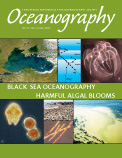First Paragraph
Radar altimeters on-board the Jason-1, TOPEX, Envisat, and GFO satellites obtained profiles of sea surface height on transects across the Indian Ocean between two and nine hours after the December 26 Sumatra earthquake. The data are received hours to days after “real time,” too late to be used in detection and warning of tsunamis. We compared the sea level anomaly profiles of December 26 measured along the satellite tracks (Figure 1D-G) with the measurements on previous passes of the same satellites 10 days, 35 days, and 17 days earlier. This allowed us to remove the majority of permanent and slowly varying features of sea level, revealing transient signals. The altimeters also provide wind speed and wave height data, and these allowed us to interpret a sea-level anomaly at 16°S in the Jason-1 profile (Figure 1D) as being due to a severe storm. The remaining sea-level anomaly signal appears to be associated with the tsunami. The signal of the leading edge two hours after the earthquake is particularly prominent, with an amplitude of 60 cm and two narrow peaks where the NOAA tsunami model forecast shows two overlapping peaks coalescing into one broad (250 km) crest. Increased sea-surface roughness at spatial scales from 150 to 15 km wavelengths also appears inside the portion of the ocean excited by the tsunami.

